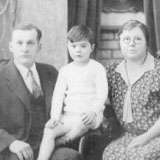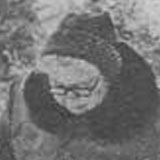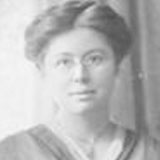Biography: Dr. Kate Pellham Newcomb

Kate Pellham Newcomb, M.D., left her practice in New York City to care for her husband and nurse him back to better health. Living in rural Wisconsin so he could benefit from the clean, country air, she gradually returned to medicine, working as one of only three doctors in the area. She traveled miles every day to reach patients isolated in the countryside. In 1949, Dr. Newcomb marshaled the community to raise funds for a hospital, to improve the medical care available to all residents.
Kate Pelham was born in Wellington, Kansas, in 1886. After her mother died (when Kate was only 3 years old), she was raised by her grandparents until her father remarried. The family moved to Buffalo, New York, where Kate Pelham graduated high school in 1900 and became a teacher. She had wanted to go to medical school, but was forbidden by her father who thought it was unladylike. When her stepmother died, her father wanted her to serve as his social hostess, but she was unenthusiastic and seemed unable to perform the role particularly well. Pelham's father eventually gave up on his plans for her and agreed to let her attend medical school.
Dr. Pelham earned her M.D. from the University of Buffalo in 1917. Planning to practice in the city, she turned down a proposal of marriage from a fellow student who wanted to set up his practice in the country. Instead, she worked in poor neighborhoods in New York and Detroit. There she met and married William (Bill) Newcomb, an auto-plant worker. Because of the dangers of Dr. Newcomb's late-night home visits to very poor neighborhoods, Bill used to drive her to night calls for her own safety. Just a few years after their marriage, he became ill with a lung disease and moved to the north woods of Wisconsin in the hope that his condition would improve in the fresh country air. Although at first she was reluctant to leave the city, Dr. Newcomb soon followed, giving up her practice to care for her husband.
Dr. Newcomb lost her faith in doctors and the medical profession after the death of her first-born son, who never recovered from the anesthesia she received during labor. The couple went on to have a second son, named William Thomas, in 1928. Although Dr. Newcomb had never applied for a license to practice medicine in Wisconsin, she was persuaded to return to the profession by one of the two doctors in the area. She visited Dr. Torpy after her son had suffered a minor accident, and she had bandaged his injured wrist. Realizing that Dr. Newcomb was a qualified physician, he called for her assistance in an emergency case later that day, ending her ten-year hiatus from medical practice.
From 1931 to 1942 she saw patients at her home in Rice Creek in Boulder Junction, Wisconsin, and her office hours in the town halls in the northern communities, driving 100 miles a day to visit patients in the most isolated areas. In 1942 she bought a house in Woodruff, where she had her office until her death in 1956.
Dr. Newcomb often made house calls, spending about three hours a day traveling between patients. Throughout her career she delivered some 3000 babies, and never lost a mother. There are legendary stories of her journeys to help patients, tales of walking more than two miles on snowshoes in sub-zero temperatures when even the snowplow couldn't get through. Her Model T Ford was even fitted with skis.
In 1949, Dr. Newcomb began fundraising for a community hospital in Woodruff, Wisconsin. An association was formed to raise funds, and Dr. Newcomb helped rally the community. Land, materials, and labor were donated and many community fundraising efforts took place. A special tax was even levied by local citizens to raise the funds. In 1952, the children in the geometry class at the Arbor Vitae-Woodruff High School, many of whom had been delivered by Dr. Newcomb, were studying the concept of a "million." One of the students suggested they collect a million pennies to give to the hospital fund drive. The pennies were sent from all forty-eight states and all continents in just 103 days. On Memorial Day weekend in 1953 a Million Penny Parade was held to celebrate the students' successful fund drive, and the pennies were put on display in the school gym. When Lakeland Memorial Hospital opened in March 1954, the second Penny Parade featured ninety floats (led by Dr. Kate), and fifteen marching bands, attracting an audience of 25,000 people.
Dr. Newcomb died only a few years after the hospital opened, as a result of a fall while leaving a public health meeting. In 2003, the fiftieth anniversary of the Penny Parade, the town of Woodruff plans to marks its community spirit and the woman who inspired it, 'Dr. Kate'.






